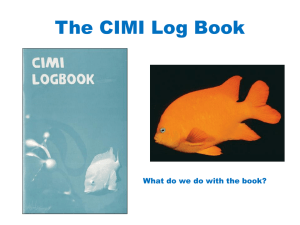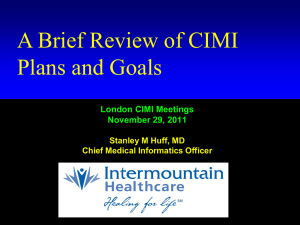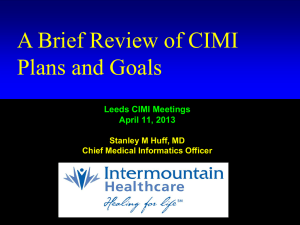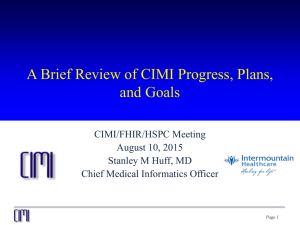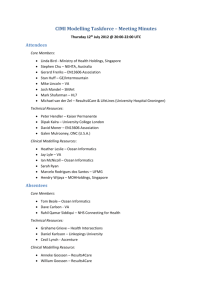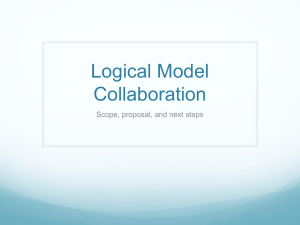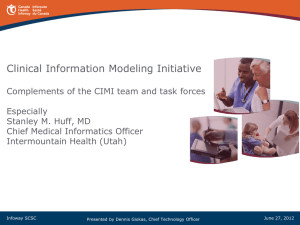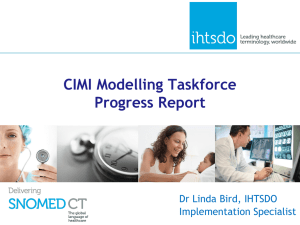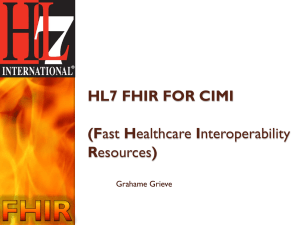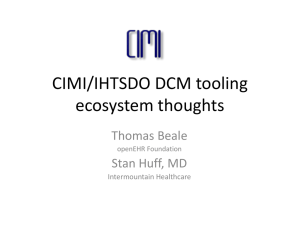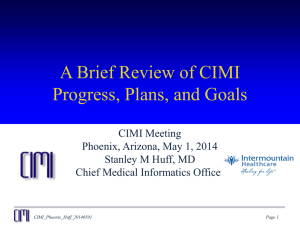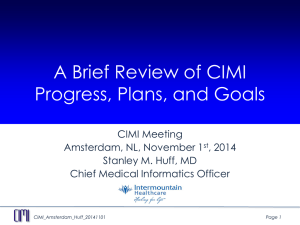A Brief Review of CIMI Progress, Plans, and Goals
advertisement
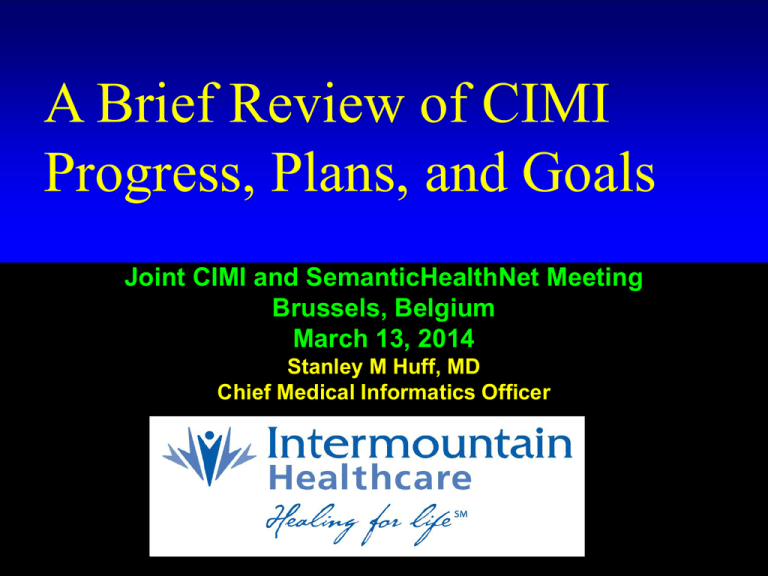
A Brief Review of CIMI Progress, Plans, and Goals Joint CIMI and SemanticHealthNet Meeting Brussels, Belgium March 13, 2014 Stanley M Huff, MD Chief Medical Informatics Officer Huff # 1 CIMI Executive Committee • • • • • • • Stan Huff Virginia Riehl Nicholas Oughtibridge Jamie Ferguson Jane Millar Tom Jones Colleen Brooks Huff # 2 CIMI Modeling Taskforce • • • • • • • • • • • • Linda Bird Harold Solbrig Thomas Beale Gerard Freriks Michael van der Zel Rahil Siddiqui Daniel Karlson Stephen Chu Mark Shafarman Galen Mulroney Sarah Ryan David Karlson • • • • • • • • • • • • Heather Leslie Ian McNicoll Michael Lincoln Anneke Goossen William Goossen Jay Lyle Josh Mandel Grahame Grieve Dipak Kalra Cecil Lynch David Moner Peter Hendler #3 Intermountain’s Motivation for CIMI The Ultimate Value Proposition of CIMI • Interoperable sharing of: – Data – Information – Applications – Decision logic – Reports – Knowledge Huff # 5 Patient Core Assumptions ‘The complexity of modern medicine exceeds the inherent limitations of the unaided human mind.’ ~ David M. Eddy, MD, Ph.D. ‘... man is not perfectible. There are limits to man’s capabilities as an information processor that assure the occurrence of random errors in his activities.’ ~ Clement J. McDonald, MD James # 8 • Newborns w/ hyperbilirubinemia 50 50 B iliru b in > 1 9 .9 m g /d L B iliru b in > 2 5 m g /d L 40 40 34 34 34 32 32 31 30 30 28 30 28 26 27 26 26 24 27 27 25 24 22 20 21 20 19 17 16 20 16 16 14 14 15 15 15 13 16 15 13 13 12 10 10 n 1 0 ar 0 0 0 0 0 ay 1 0 04 ar 0 M 1 0 M 1 0 M 20 03 ov N Ja ep S l Ju ay 0 M ar 02 20 n 2 1 20 2 n 1 ov 1 N 1 ep 2 S 1 l 2 Ju 2 ay 1 M 2 0 ov N 10 3 2 0 Ja ep S l 0 10 Ja 3 2 Ju M 01 20 ar 3 0 ay 0 0 3 2 M 3 1 M N um be r of pa tie nts 37 James # 9 Clinical System Approach Intermountain can only provide the highest quality, lowest cost health care with the use of advanced clinical decision support systems integrated into frontline clinical workflow Decision Support Modules • • • • Antibiotic Assistant Ventilator weaning ARDS protocols Nosocomial infection monitoring • MRSA monitoring and control • Prevention of Deep Venous Thrombosis • Infectious disease reporting to public health • • • • • • • • • • Diabetic care Pre-op antibiotics ICU glucose protocols Ventilator disconnect Infusion pump errors Lab alerts Blood ordering Order sets Patient worksheets Post MI discharge meds Strategic Goal • Be able to share data, applications, reports, alerts, protocols, and decision support modules with anyone in the WORLD • Goal is “plug-n-play” interoperability 5 Layer Architecture (from Catalina MARTÍNEZ-COSTA, Dipak KALRA, Stefan SCHULZ) Vendor Work SMART on FHIR – Architecture (from David McCallie) Blue Button Pull (mHealth) FHIR / HTTPS HTTPS or SOAP SOA-like API (FHIR) Trusted Applications Registry Web App Servers FHIR Open Platform Services FHIR + CEM + OAuth2 FHIR SMART SMART App App • Transport FHIR / HTTPS SMART Container • CEMs FHIR Profiles (HTML - MPage) • UX SMART App Platform • Mobile Apps BB-Pull • SOA-like API FHIR + ? • Security OAuth2 EHR Platform 14 CIMI Vision, Mission, and Goals What Is Needed to Create a New Paradigm? • Standard set of detailed clinical data models coupled with… • Standard coded terminology • Standard API’s (Application Programmer Interfaces) for healthcare related services • Open sharing of models, coded terms, and API’s • Sharing of decision logic and applications Clinical modeling activities • • • • • • • • • • • • • • Netherlands/ISO Standard ISO EN 13606 UK – NHS and LRA Singapore Sweden Australia openEHR Foundation Canada US Veterans Administration US Department of Defense Intermountain Healthcare Mayo Clinic MLHIM Others…. • SemanticHealthNet • HL7 – Version 3 RIM, message templates – TermInfo – CDA plus Templates – Detailed Clinical Models – greenCDA • Tolven • NIH/NCI – Common Data Elements, CaBIG • CDISC SHARE • Korea • Brazil # 18 Clinical Information Modeling Initiative Mission Improve the interoperability of healthcare systems through shared implementable clinical information models. (A single curated collection.) Huff # 19 Clinical Information Modeling Initiative Goals • Shared repository of detailed clinical information models • Using a single formalism (now support two!) • Based on a common set of base data types • With formal bindings of the models to standard coded terminologies • Repository is open and models are free for use at no cost Huff # 20 Goal: Models that support multiple contexts • • • • • • • • EHR data storage Message payload and service payload Decision logic (queries of EHR data) Clinical trials data (clinical research) Quality measures Normalization of data for secondary use Creation of data entry screens (like SDC) Capture of coding output from NLP Information Model Ideas CEM V2 “|” LRA V2 XML HTML V3 XML FHIR AML Translators Standard Terminologies And Ontologies CEMs DCMs CDA Templates Repository of Shared Models in an approved Formalism Realm Realm Specific Realm Specific Specializations Realm Specific Specializations Localization Specific Specializations and Context Specializations Specialization openEHR Archetypes ISO EN 13606 Archetypes LRA Models FHIR Resources Initial Loading of Repository Translators Translators ADL CDA OWL SOA CDISC SHARE CEN Payload Archetype # 22 Roadmap (some parallel activities) • Choose supported formalism(s) • Define the core reference model, including data types (leaf types) • Define our modeling style and approach – Patterns – Development of “style” will continue as we begin creating content Roadmap (continued) • Create an open shared repository of models – Requirements – Find a place to host the repository – Select or develop the model repository software • Create model content in the repository – Start with existing content that participants can contribute – Must engage clinical experts for validation of the models Roadmap (continued) • Create a process (editorial board?) for curation and management of model content • Resolve and specify IP policies for open sharing of models • Find a way of funding and supporting the repository and modeling activities • Create tools/compilers/transformers to other formalisms – Must support at least ADL, UML/OCL, Semantic Web, HL7 • Create tools/compilers/transformers to create what software developers need (joint work) – Examples: XML schema, Java classes, CDA templates, greenCDA, RFH, SMART RDF, etc. Modeling at Intermountain • 1994 – Models using Abstract Syntax Notation 1 (ASN.1) • ~ 2000 – attempt modeling with XML Schema – No terminology binding capabilities, no constraint language • 2004 – models using Clinical Element Modeling Language (CEML), 5000+ models • 2009 – models converted to Constraint Definition Language (CDL) • 2013 – models converted back to CEML • 2014 – models in ADL, and FHIR profiles Intermountain Plans • Continue to use CEML internally for now • Intermountain models are available at – www.clinicalelement.com • Translate CEML models to ADL 1.5 • Contribute converted models to CIMI • Place models in the CIMI repository with “proposed status” • Models reviewed and modified to conform to CIMI standards and style Selected CIMI Policies, Decisions, and Milestones Decisions (London, Dec 1, 2011) • We agreed to: – ADL 1.5 as the initial formalism, including the Archetype Object Model – A CIMI UML profile (Archetype Modelling Language, AML) will be developed concurrently as a set of UML stereotypes, XMI specifications and transformations Definition of “Logical Model” • Models show the structural relationship of the model elements (containment) • Coded elements have explicit binding to allowed coded values • Models are independent of a specific programming language or type of database • Support explicit, unambiguous query statements against data instances Implementation Strategy • As needed, we will make official mappings from the CIMI logical models to particular implementations (logical data types -> physical data types) – FHIR – CCDA – HL7 V3 messaging – Etc. Further modeling decisions • One or more Examples of instance data will be created for each model – The examples can show both proper and improper use • Models shall specify a single preferred unit of measure (unit normalization) • Models can support inclusion of processing knowledge (default values) IsoSemantic Models – Example of Problem (from Dr. Linda Bird) e.g. “Suspected Lung Cancer” IsoSemantic Models – Example Instances (from Dr. Linda Bird) e.g. “Suspected Lung Cancer” Isosemantic Models • CIMI supports isosemantic clinical models: – We will keep isosemantic models in the CIMI repository that use a different split between pre-coordination versus post coordination (different split between terminology and information model) – One model in an isosemantic family will be selected as the preferred model for interoperability (as opposed to everyone supporting every model) – Profiles of models for specific use cases will be created by authoritative bodies: professional societies, regulatory agencies, public health, quality measures, etc.) Terminology • SNOMED CT is the primary reference terminology • LOINC is also approved as a reference terminology – In the event of overlap, SNOMED CT will be the preferred source • CIMI will propose extensions to the reference terminologies when needed concepts do not exist – CIMI will have a place to keep needed concepts that are not a part of any standard terminology • CIMI has obtained a SNOMED extension identifier • CIMI will adhere to IHTSDO Affiliate’s Agreement for referencing SNOMED codes in models – Copyright notice in models, SNOMED license for all production implementations • CIMI will create a Terminology Authority to review and submit concepts to IHTSDO as appropriate Terminology (cont) • The primary version of models will only contain references (pointers) to value sets • We will create tools that read the terminology tables and create versions of the models that contain enumerated value sets (as in the current ADL 1.5 specification) March 29, 2012 – Semantic Interoperability • CIMI models must be capable of supporting semantic interoperability across a federation of enterprises • We will define the relationship between each parent and child node in the hierarchy • SNOMED relationship concepts will be used to define the parent-child relationships in the models • Goal: Enable use of the SNOMED CT concept model to support translation of data from pre coordinated to post coordinated representations Content Ownership and Intellectual Property • Those who contribute models to CIMI will retain ownership and the IP of the models, but they grant CIMI a license to use the model content at no cost in perpetuity and to allow CIMI to sublicense the use of the models at no cost to those who use the models Leeds – CIMI Website • The group accepted a proposal from Portavita to provide a CIMI website. The website would: – Provide descriptive, historical, and tutorial kinds of information about CIMI – Act as a distribution site for CIMI models and other CIMI artifacts (MimdMaps, Tree Display, Examples) Leeds – Editorial Board – The requirements for approval of CIMI content will be developed and approved by the usual CIMI work processes (and not by the EB) • Style guide and related policies – The EB has the responsibility to document the process for approving official CIMI content – The EB approves roles and access permissions for specific individuals relative to management of the CIMI repository – The EB ensures that approved processes are followed, and reports regularly to the EC First draft CIMI models now available: HTTP://WWW.CLINICALELEMENT.COM/CIMI-BROWSER/ Some Principles • CIMI DOES care about implementation. There must be at least one way to implement the models in a popular technology stack that is in use today. The models should be as easy to implement as possible. • Only use will determine if we are producing anything of value – Approve “Good Enough” RM and DTs – Get practical use ASAP – Change RM and DTs based on use Primary Near Term Goals • As soon as possible, make some high quality CIMI models available in a web accessible repository – ADL 1.5 (AOM framework) and/or UML (AML, XMI) – That use the CIMI reference model – That have complete terminology bindings • • • • Get the models used in someone’s working system Document our experience Improve our processes and models Repeat! Current Issues and Work Items • Finalize the approach for modeling panels – The question of “Entries in entries” • Finalize terminology binding syntax and policies • Approach to creating examples of data instances • Further specification of standards for graphical representation of the models • Progress on Archetype Modeling Language • Continue modeling work • Progress on CIMI website Possible Topics for Discussion Relation of CIMI to other Initiatives • HL7 RIM • US FHIM • UK LRA • LEGOs • openEHR • ISO EN 13606 • CDA and CCDA • IHTSDO • FHIR • Quality models • SMART • SHARP • HL7 CDS VMR Possible Issues for Discussion • CIMI reference model – Data types • URIs for coded items – Simplifications – “Entries in entries” question • Modeling “style” – use of patterns • Supporting multiple contexts of use • Terminology binding – “Relationship” bindings – HL7 binding capabilities – static/dynamic, strong/weak • • • • The essential need for instance examples Isosemantic models Standardization of graphical representations Alignment with HL7 FHIR
